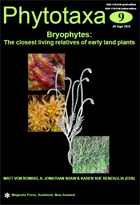Abstract
The 'Pantepui' region of northern South America comprises about 50 topographic islands above a lowland/upland rainforest matrix and constitutes a model of choice for testing island theory hypotheses in a continental setting. Although the Guiana Highlands are considered as the second most important center of endemism in the Neotropics for hepatics, the 10% endemism rates at the species level in liverworts, and probably even less in mosses, pale in comparison of the 42% of endemic angiosperm species. While about 60% of angiosperm endemics are distributed on a single tepui, single-tepui endemics represent only 1/3 of endemic liverworts and only one single-tepui endemic moss species has been described to date. These observations point to a higher dispersal ability of bryophytes as compared to angiosperms and may account for the contrasting rates of endemism between the two groups. In contrast to the vertical displacement hypothesis, which proposes that endemic tepui species originated from niche diversification and local adaptation during vertical migrations in the course of glacial/interglacial cycles, the Amazonian element represents only about 10% of the liverwort flora. By contrast, 1/2-2/3 of the species belong to the montane Neotropical element. The recurrent disjunctions observed between the Andes and the Pantepui region suggest that the bulk of endemic species in the Pantepui area might have originated by dispersal from cold-adapted Andean ancestors.

